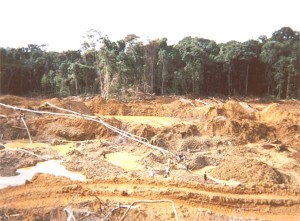An experimental gold-mining project in Choco, Colombia, designed to integrate the economic demands of the local communities with the imperative of environmental protection could be emulated in Guyana if agreement can be secured amongst the principal stakeholders in the gold-mining sector.

This newspaper has been provided with information by the World Wildlife Fund (WWF) on the Green Gold Project, an experimental initiative by Green Gold Coalition, an environmental protection project, which offers favourable prices for gold produced under environmentally responsible conditions certified by the coalition.
A documentary of the Green Gold Project viewed by Stabroek Business indicates the history of the project in efforts to halt the environmental destruction and damage to human health resulting from environmentally unsound mining practices, some of which are similar to practices that prevail in Guyana’s mining sector.
Green Gold mining seeks to eradicate the indiscriminate felling of trees and the large scale removal of irreplaceable top soil in mining areas, the use of mercury and cyanide in gold production and the discoloration and pollution of rivers and streams with effluent from mining operations.
Green Gold Coalition has secured the collaboration of the Colombian Green Gold Network to ensure adherence to a number of ‘principles’ that underpin Green Gold certification. These include the avoidance of ecological destruction to a point where it cannot easily be repaired; a ban on the use of all toxic substances in gold production; replacement of top soil in mined out areas; levels of felling and pooling that are within the local capacity to repair; controls on silt release into streams and rivers; prior permission from local communities to conduct mining operations; the establishment of biodiversity indicators and the adherence to local, regional and national environmental and mining laws.
Operators in the local mining sector whose views were sought on the idea of replicating Green Gold practices in Guyana told Stabroek Business that such measures could only be successfully applied here if their application is preceded by a re-examination of the framework of rules and institutions governing the mining sector. According to a local businessman with interests in the mining sector “the transgression of rules and the level of disregard for national laws in the local mining sector is too far advanced to be halted overnight.”
Problems associated with the felling of forests, the pollution of rivers and streams and illegal mining operations on ancestral Amerindian lands continue to plague the local mining sector and the legal mechanisms put in place to regulate interior mining have been attended by a conspicuous lack of enforcement capacity.
According to the miner with whom Stabroek Business spoke, “anything remotely resembling the Green Gold Project in Guyana can only bear fruit if government invests in enhancing the capacity of the Guyana Geology and Mines Commission (GGMC) to police the Green Gold conditions.
And according to the miner, the Green Gold conditionalities which include “a certain amount of correction of environmental damage” are likely to add to the cost of mining operations to an extent that could prove sufficiently prohibitive to close down many of the smaller gold-mining operations in the interior.
Under the experimental Green Gold project gold and gold jewellery that meets the project’s certification standards benefit from preferential international prices while miners receive various forms of technical assistance through the Green Gold Coalition.
Such assistance includes various types of technology transfer and training in ecological restoration techniques.




